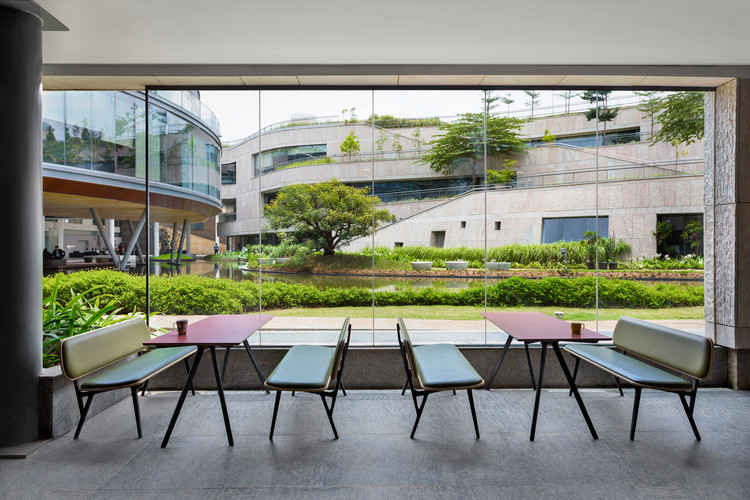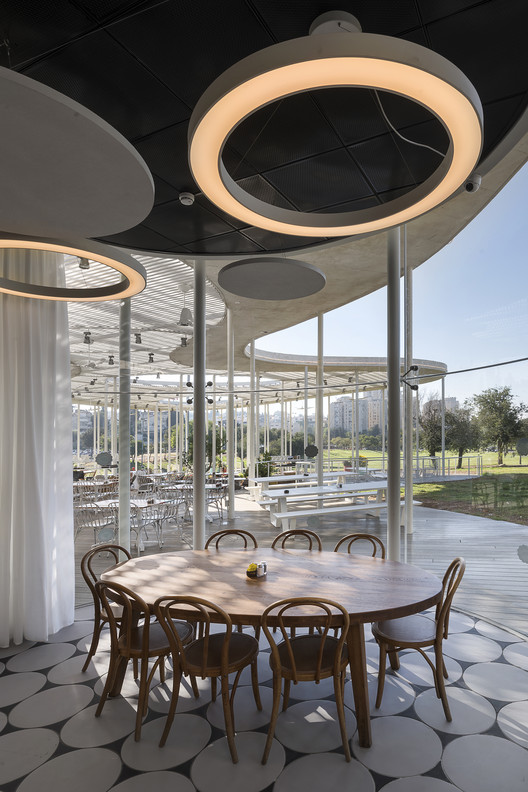JKC1 Ong-Ong Architects
2012-10-15 01:00
架构师提供的文本描述。这个优质的平房位于新加坡的布基提马区.自然窗帘的茂盛的热带树木包围了网站,而它的稍微倾斜的地形为房子本身提供了一个理想的位置。
Text description provided by the architects. This good-class bungalow is located in Singapore's Bukit Timah district. A natural curtain of lush tropical trees surrounds the site, whilst its slightly slopping terrain offers an ideal location for the house itself.
入口的轴线与地块较长的一侧相邻,在房子前面有一个更大的花园和游泳池。一条车道通向车库所在的房子后面,小心地从外面对它进行检查。
The axis of the entrance is adjacent to one of the plot's longer sides, allowing for a bigger garden and pool space in front of the house. A driveway leads to the rear of the house where the garage is located, discreetly screening it from the outside.
在建筑上,概念是保持一般的设计微妙,优先考虑周围的自然口袋。因此,这座建筑提供了一个理想的有利条件,从这里可以畅通无阻地欣赏到环绕着的绿色植物。同时,该建筑融入了环境,吸收了部分绿地空间,在里面创造了一个花园。
Architecturally, the concept was to keep the general design subtle, giving precedence to the surrounding pockets of nature. As such, the building provides an ideal vantage point from which to enjoy unobstructed views of the encompassing greenery. At the same time, the building blends into the setting, absorbing sections of green space to create a garden within.
建筑物的线条主要是水平的,平衡了周围树木的垂直度。游泳池一侧的可伸缩玻璃面板显着地打开了房子的外部空间,同时也注意到了隐私的需要。
The building's lines are predominantly horizontal, balancing out the verticality of the trees lining the site's periphery. Retractable glass panels on the pool-facing side dramatically open up the house to the outside, whilst also being mindful of the need for privacy.
从平房的社交圈里,人们可以欣赏到周围绿色植物的不间断景观。生活和就餐区的整合,以及图书馆,创造了一个巨大的、统一的空间,在这个空间里,有着无限的选择来进行不同的互动。循环通道和服务区位于大楼后面的深处,里面还有一间带套间浴室的客房。在后面还有一个大厨房,它延伸到整栋房子里,这使它成为一个大聚会的理想场所,其中包括做饭和吃饭。额外的服务区被安置在厨房下面的一个自然通风的地下室。
From the social areas of the bungalow, one can relish uninterrupted views of the surrounding greenery. The integration of the living and dining areas, along with the library, creates a large, unified space within which there are infinite choices for a diversity of interactions. The circulation pathway and service areas are tucked deep inside at the back of the building, where there is also a guest bedroom with ensuite bathroom. Also in the back is a grand kitchen that extends across the entire length of the house, making it an ideal setting for big gatherings where cooking and eating are involved. Additional service areas are housed directly below the kitchen in a naturally-ventilated basement.
一个楼梯从一楼通向第二层,分裂成两个翅膀,就在石花园前,光线通过那里进入建筑物的核心。卧室位于这个内部花园周围,这使得它成为一个中心特征,也是建筑的象征中心。
A staircase leads from the ground floor to the second storey, splitting into two wings just before the stone garden through which light filters into the core of the building. The bedrooms are positioned around this internal garden, thus making it a central feature as well as the symbolic heart of the building.
每个卧室都足够宽敞,可以容纳步入式衣柜和套房浴室,而一个家庭房间和书房构成了另一个公共空间。各自的阳台被合并在一起,形成一个长而连续的边界围绕在该层周围。为了保持隐私,同时又不贬低阳台的开放氛围,沿途的反射池被分散在一起,同时也提供了冷却的缓解。
Each bedroom is spacious enough to accommodate walk-in wardrobes as well as ensuite bathrooms, while a family room and study area form another communal space. The respective balconies are merged together to form a long and continuous border around the perimeter of that floor. To maintain privacy without downplaying the open atmosphere of the balcony, reflective ponds are interspersed along the way while also providing cooling relief.
进入木材甲板屋顶露台是通过一个钢板螺旋楼梯。材质和颜色无缝地融入自然全景,为社交活动创造了一个舒适的空间。
Access to the timber-decked roof terrace is via a steel sheet spiral staircase. The material textures and colours blend seamlessly into the natural panorama, creating a comfortable space for social gatherings.
房子的一个主要的可持续的特点是使用悬臂板来保护室内空间免受阳光直射,同时也提供了大量的自然光照。此外,二楼阳台上的滑动木板也允许调节阳光和遮阳。
One main sustainable characteristic of the house is the use of cantilevering slabs to shield the interior spaces from direct sunlight, whilst also providing a substantial degree of natural illumination. Furthermore, sliding timber panels on the second floor's balcony also permit regulation of sunlight and shade.
整个建筑都采用了交叉通风策略,以确保房屋有足够的风循环来自然冷却各种空间。二楼的小池塘也是自然冷却的额外来源。其结果是,在不影响热舒适的最佳条件的情况下,降低了电能消耗。
A cross ventilation strategy was applied throughout the building to ensure that the house has adequate wind circulation to cool the various spaces naturally. The small ponds on the second floor are also additional sources of natural cooling. As a result, electrical energy consumption is reduced without compromising on the optimal conditions for thermal comfort.
门面由一些基本材料组成,如车费混凝土、粗糙的石头、木材和玻璃。表面看起来是多孔的和有机的,建筑物的皮肤有一个原始的质感,与在内部使用的光滑的饰面形成了很好的对比。这种粗糙和光滑的材料的和谐结合是一个令人耳目一新的有趣的概念,现代家庭的家。
The façade is composed of a selection of basic materials, such as fare-faced concrete, rough stone, timber and glass. Seemingly porous and organic, the building's skin has a raw texture that contrasts nicely with the smoother finishes used in the interior. This harmonious combination of rough and smooth materials is a refreshingly interesting concept for the modern family home.
虽然最初的简介主要集中在结构强调其自然环境,但在设计过程中,实现了一个独特的平衡,房子和绿色植物是相辅相成的。
Although the original brief focused mainly on having the structure accentuate its natural surroundings, through the course of the design process, a unique balance was achieved where the house and greenery were one with each other.
 举报
举报
别默默的看了,快登录帮我评论一下吧!:)
注册
登录
更多评论
相关文章
-

描边风设计中,最容易犯的8种问题分析
2018年走过了四分之一,LOGO设计趋势也清晰了LOGO设计
-

描边风设计中,最容易犯的8种问题分析
2018年走过了四分之一,LOGO设计趋势也清晰了LOGO设计
-

描边风设计中,最容易犯的8种问题分析
2018年走过了四分之一,LOGO设计趋势也清晰了LOGO设计










































































































